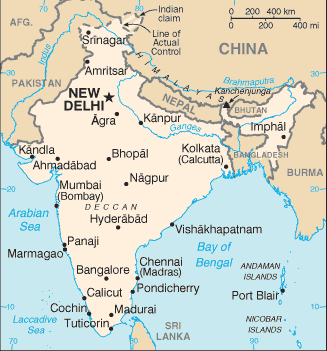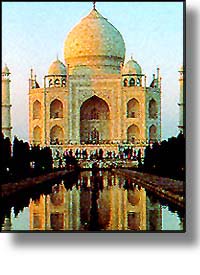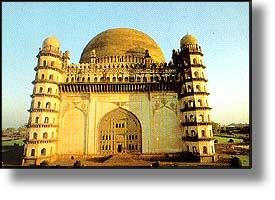India
India's
History | Adventure
in India | Asia
Homepage
The
World
 "So far as I am
able to judge, nothing has been left undone, either by
man or nature, to make India the most extraordinary country
that the sun visits on his rounds. Nothing seems to have
been forgotten, nothing overlooked." --Mark Twain,
from Following the Equator "So far as I am
able to judge, nothing has been left undone, either by
man or nature, to make India the most extraordinary country
that the sun visits on his rounds. Nothing seems to have
been forgotten, nothing overlooked." --Mark Twain,
from Following the Equator
It
is impossible not to be astonished by India. Nowhere on Earth
does humanity present itself in such a dizzying, creative
burst of cultures and religions, races and tongues. Every
aspect of the country presents itself on a massive, exaggerated
scale, worthy in comparison only to the superlative mountains
that overshadow it. Perhaps the only thing more difficult
than to be indifferent to India would be to describe or understand
India completely.
Location, Geography, & Climate
 Set apart from the rest of Asia by the supreme
continental wall of the Himalayas, the Indian subcontinent
touches three large bodies of water and is immediately recognizable
on any world map. It is the huge, terrestrial beak between
Africa and Indonesia. This thick, roughly triangular peninsula
defines the Bay of Bengal to the east, the Arabian sea to the
west, and the India Ocean to the south. Set apart from the rest of Asia by the supreme
continental wall of the Himalayas, the Indian subcontinent
touches three large bodies of water and is immediately recognizable
on any world map. It is the huge, terrestrial beak between
Africa and Indonesia. This thick, roughly triangular peninsula
defines the Bay of Bengal to the east, the Arabian sea to the
west, and the India Ocean to the south.
India's puzzleboard of 26 states holds virtually
every kind of landscape imaginable. An abundance of mountain
ranges and national parks provide ample opportunity for eco-tourism
and trekking, and its sheer size promises something for everyone.
From its northernmost point on the Chinese border, India extends
a good 2000 miles (3200 km) to its southern tip, where the
island nation of Sri Lanka seems to be squeezed out of India
like a great tear, the synapse forming the Gulf of Mannar.
India's northern border is dominated mostly by Nepal and the
Himalayas, the world's highest mountain chain. Following the
sweeping mountains to the northeast, its borders narrow to
a small channel that passes between Nepal, Tibet, Bangladesh,
and Bhutan, then spreads out again to meet Burma in area called
the "eastern triangle." Apart from the Arabian sea,
its western border is defined exclusively by Pakistan.
 India can be organized along the compass
points. North India, shaped like a throat and two lungs, is
the country's largest region. It begins with the panhandle
of Jammu and Kashmir, a dynamic area with terrain varying from
arid mountains in the far north to the lake country and forests
near Sringar and Jammu. Falling south along the Indus river
valley, the North becomes flatter and more hospitable, widening
into the fertile plains of Punjab to the west and the Himalayan
foothills of Uttar Pradesh and the Ganges river valley to the
East. Cramped between these two states is the capital city,
Delhi. The southwestern extremity of the North is the large
state of Rajastan, whose principal features are the Thar
Desert and the stunning "pink city" of Jaipur.
To the southeast is southern Uttar Pradesh and Agra, home of
the famous Taj Mahal. India can be organized along the compass
points. North India, shaped like a throat and two lungs, is
the country's largest region. It begins with the panhandle
of Jammu and Kashmir, a dynamic area with terrain varying from
arid mountains in the far north to the lake country and forests
near Sringar and Jammu. Falling south along the Indus river
valley, the North becomes flatter and more hospitable, widening
into the fertile plains of Punjab to the west and the Himalayan
foothills of Uttar Pradesh and the Ganges river valley to the
East. Cramped between these two states is the capital city,
Delhi. The southwestern extremity of the North is the large
state of Rajastan, whose principal features are the Thar
Desert and the stunning "pink city" of Jaipur.
To the southeast is southern Uttar Pradesh and Agra, home of
the famous Taj Mahal.
West India contains the states of Gujarat,
Maharashtra, Goa, and part of the massive, central state of
Madhya Pradesh. The west coast extends from the Gujarat peninsula
down to Goa, and it is lined with some of India's best beaches.
The land along the coast is typically lush, with rainforests
reaching southward from Bombay all the way to into Goa. A long
mountain chain, the Western Ghats, separates the verdant coast
from the Vindya mountains and the dry Deccan plateau further
inland.
Home of the sacred Ganges river and the majority
of Himalayan foothills, East India begins with the states of
Madhya Pradesh, Bihar, Orissa, which comprise the westernmost
part of the region. East India also contains an area known
as the eastern triangle, which is entirely distinct. This is
the last gulp of land that extends beyond Bangladesh, culminating
in the Naga Hills along the Burmese border.
India reaches its peninsular tip with South
India, which begins with the Deccan in the north and ends with
Cape Comorin, where Hindus believe that bathing in the waters
of the three oceans will wash away their sins. The states in
South India are Karnataka, Andhra Pradesh, Tamil Nadu, and
Kerala, a favorite leisure destination. The southeast coast,
mirroring the west, also rests snugly beneath a mountain range---the
Eastern Ghats.
Because of India's size, its climate depends
not only on the time of year, but also the location. In general,
temperatures tend to be cooler in the north, especially between
September and March. The south is coolest between November
to January. In June, winds and warm surface currents begin
to move northwards and westwards, heading out of the Indian
Ocean and into the Arabian Gulf. This creates a phenomenon
known as the south-west monsoon, and it brings heavy rains
to the west coast. Between October and December, a similar
climatic pattern called the north-east monsoon appears in the
Bay of Bengal, bringing rains to the east coast. In addition
to the two monsoons, there are two other seasons, spring and
autumn.
Though the word "monsoon" often
brings to mind images of torrential floods and landslides,
the monsoon seasons are not bad times to come to India. Though
it rains nearly every day, the downpour tends to come and go
quickly, leaving behind a clean, glistening landscape.
Culture & People
 With
nearly 1 billion citizens, India is the second most populous
nation in the world. It is impossible to speak of any one Indian
culture, although there are deep cultural continuities that
tie its people together. English is the major language of trade
and politics, but there are fourteen official languages in
all. There are twenty-four languages that are spoken by a million
people or more, and countless other dialects. India has seven
major religions and many minor ones, six main ethnic groups,
and countless holidays. With
nearly 1 billion citizens, India is the second most populous
nation in the world. It is impossible to speak of any one Indian
culture, although there are deep cultural continuities that
tie its people together. English is the major language of trade
and politics, but there are fourteen official languages in
all. There are twenty-four languages that are spoken by a million
people or more, and countless other dialects. India has seven
major religions and many minor ones, six main ethnic groups,
and countless holidays.
Religion is central to Indian culture, and
its practice can be seen in virtually every aspect of life
in the country. Hinduism is the dominant faith of India, serving
about 80 percent of the population. Ten percent worship Islam,
and 5 perscent are Sikhs and Christians; the rest (a good 45
million) are Buddhists, Jains, Bahai, and more.
India's
History | Adventure
in India
|
